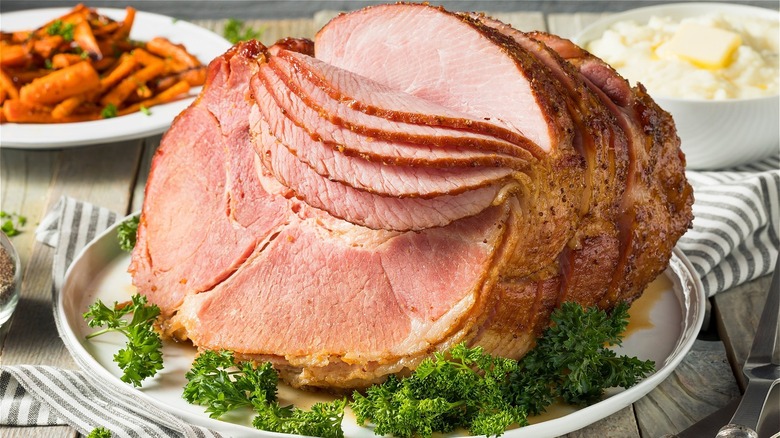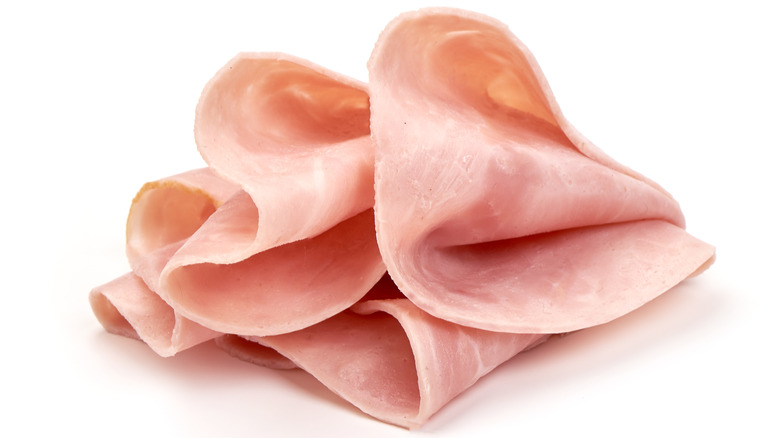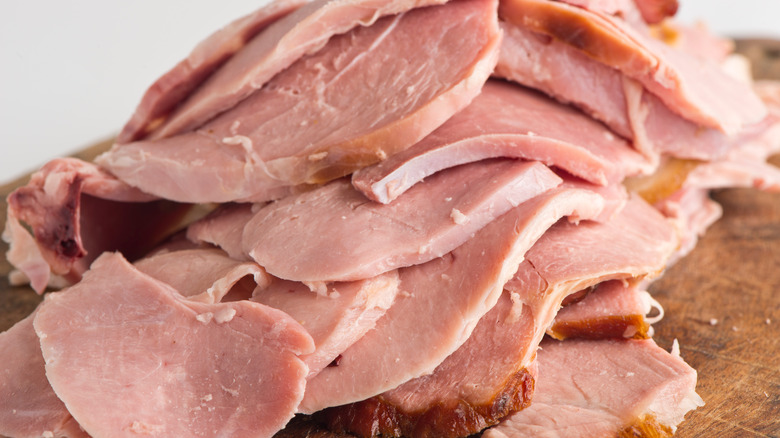How Long Should You Actually Keep Leftover Ham?
Ham is often an Easter tradition for Christian families across the United States. There are countless Easter ham recipes out there, including methods for roasting, smoking, casseroles, sandwiches, and plates full of cold cut appetizers.
The Farmers' Almanac shares a bit about the history of this food, noting that in the olden days, spring marked a time to use the last of the cured meats from the previous fall, making way for the new greens of springtime. Farmers would have slaughtered the pig the prior year and cured the meat all winter long, making this tradition more seasonal than religious.
In modern times, a giant roasted and smoked ham is still an Easter favorite, and with that favorite comes leftovers reminiscent of the overwhelming aftermath of a Thanksgiving turkey. Thankfully, there is no shortage of preparations for leftover meat — but how much ham one household can eat before it goes bad?
Leftover ham has a shelf life in the fridge
The answer to how long you should keep leftover ham differs in part based on how the ham was cooked and how it is being stored. The USDA cautions against improper storage and consumption of ham to prevent common foodborne pathogens, including Trichinella spiralis (trichinae), Staphylococcus aureus (staph), and mold — all of which can make a person quite sick.
The USDA further provides some storage guidelines on leftover ham. Fresh, cooked ham that is uncured can last in your refrigerator for three to four days and your freezer for three to four months. Cured ham that you cook at home (like on Easter) can last in the fridge for three to five days and the freezer for one to two months. Spiral-cut ham leftover from your home cooking is also good in the fridge for three to five days and in the freezer for one to two months. A cooked "country" ham can last in the fridge even longer at around seven days; in the freezer, it will be good for one to two months.
If you skipped the cooking and instead opened a pack of sliced lunchmeat-style ham, simply follow the package guidelines for storage. The same applies for canned ham products like Spam. Finally, cured items like Serrano ham or prosciutto can be refrigerated for between two and three months, making these the longest lasting ham variety in your fridge.
Warning signs that your ham is expiring
While these tips are perfect for keeping your leftover ham fresh for the next few days or weeks, you obviously can't keep it forever. At the same time, you don't want to risk tossing out a perfectly good ham based on the suggested best-by date alone. What are the other warning signs that your ham may not fresh enough to eat?
According to LEAFtv, there are a few clear signs you should look for before tossing out your ham. Expired ham can give off a rotten, sulfur-like smell or have blotches of greenish-gray or brown spots across the meat. The most noticeable warning sign is the presence of mold, which means you should not only get rid of the ham, but also anything that came into contact with it to avoid consuming cross-contaminated food. Lacademie also warns that a "slimy, sticky" texture is a tell-tale sign that your Easter ham is better off in the trash.
While these are all alarming signs to take note of, LEAFtv does note that certain types of ham (such as country hams and salami) may have an unpleasant smell and/or mold growth due to the dry curing process, yet they can still be safe to eat. If you want to eat these items anyway and are in a generally good state of health, you can clean the mold off with hot water and a brush, per the USDA.
Ways to use leftover ham
So, your leftover ham is still good to eat. While you could be the biggest ham fanatic you know, chances are you'll get bored eating the same thing every day only to make a small dent in your leftovers. You'll no doubt enjoy having your spare ham heated up with a serving of veggies, but you'll probably end up craving a more creative way to consume your holiday bounty eventually.
Fortunately, there are a ton of interesting and delicious ways to use leftover ham with simple ingredients. For lunch, grab your trusty pan or panini press to make a Cuban or Monte Cristo sandwich with melty cheese. If you're looking for something more substantial, try a quiche with homemade or store-bought pie crust, ham, eggs, cheese, and vegetables. For breakfast, mix chopped ham into a savory corn muffin batter or omelet. You could also prepare a casserole with your leftover ham, such as a Minnesota hotdish stuffed with tater tots and vegetables for a hearty dinner. Finally, you could even take a page from Ree Drummond's book and make her favorite leftover ham dish: scalloped potatoes with loads of shredded cheese, cream, and diced ham.



